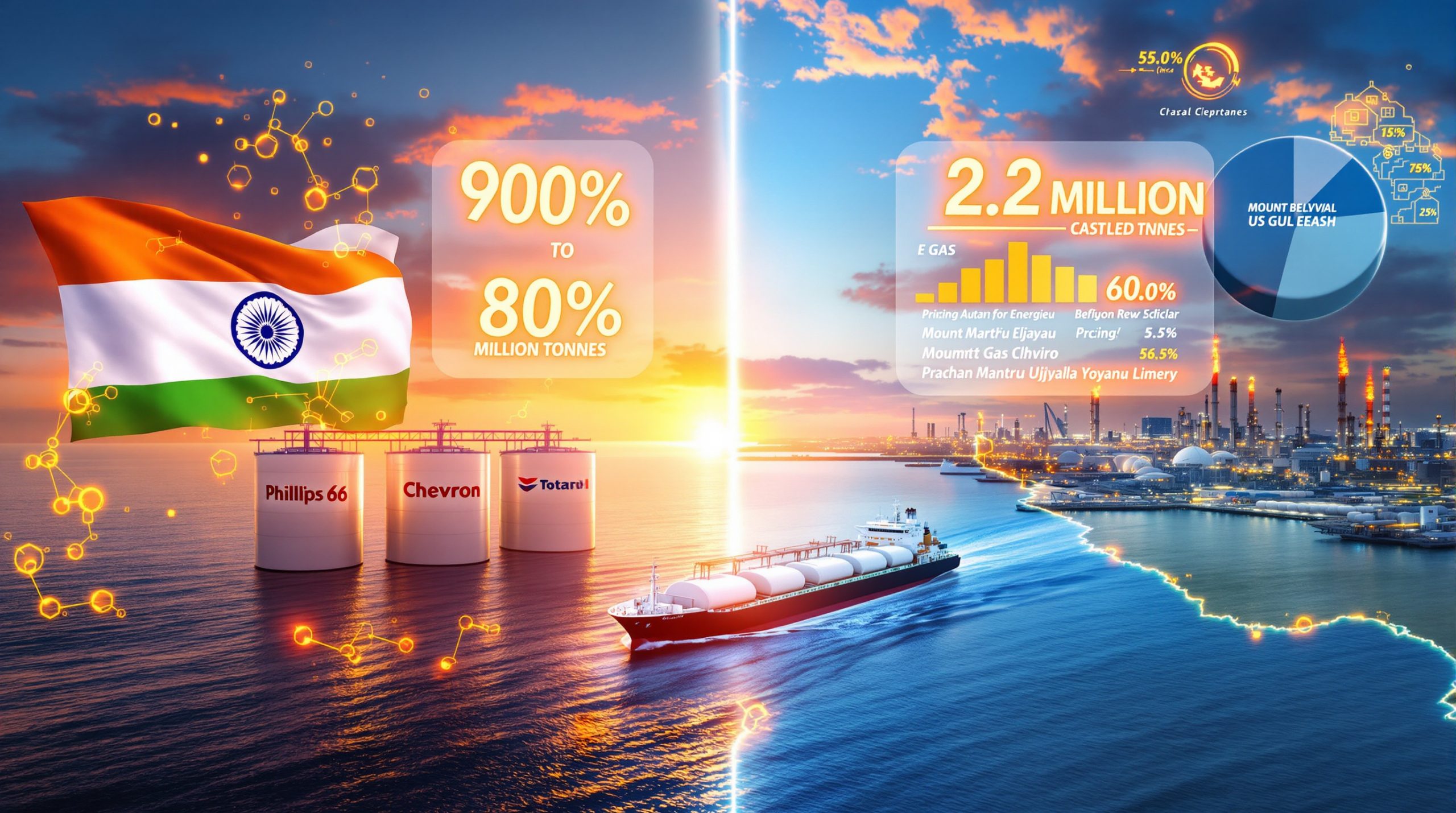Global energy markets operate within complex webs of supply dependencies, pricing mechanisms, and geopolitical relationships that shape national security strategies. For major importing nations, the concentration of energy sources within specific geographic regions creates systemic vulnerabilities that demand strategic diversification. When these nations successfully establish new supply partnerships with different geographic and political entities, the ripple effects extend far beyond commodity procurement into broader economic diplomacy and regional power balances. Furthermore, the US tariff implications of such strategic partnerships add another layer of complexity to international energy relationships.
Strategic Framework Behind India's LPG Supply Diversification
Revolutionary Shift from Spot Market Dependencies
India's energy procurement landscape has undergone a fundamental transformation through a structured India US LPG import deal involving 2.2 million tonne LPG import framework scheduled for implementation in 2026. This arrangement represents the first long-term contractual relationship between Indian state enterprises and US Gulf Coast producers, marking a departure from traditional spot-market purchasing patterns that have dominated India's energy import strategy for decades.
The agreement encompasses three major US suppliers operating under a coordinated allocation system. Phillips 66 will deliver two cargoes monthly, representing approximately 600,000 tonnes annually, while Chevron and TotalEnergies will each contribute one cargo monthly, totalling roughly 300,000 tonnes per supplier. This multi-vendor approach eliminates single-source dependency risks whilst ensuring consistent supply flows throughout the contract period.
Mount Belvieu pricing benchmark integration fundamentally alters India's cost structure exposure, shifting from Middle Eastern pricing indices to US Gulf Coast market indicators. Mount Belvieu, located in Texas, serves as North America's primary pricing hub for propane and LPG derivatives, offering different volatility patterns and hedging opportunities compared to traditional Arab Gulf reference prices. In addition, oil price movements significantly influence these pricing dynamics across regional markets.
Infrastructure Alignment and Technical Specifications
The operational framework requires precise coordination across multiple dimensions of supply chain management. US Gulf Coast terminals must align product specifications with Indian Bureau of Standards (BIS) requirements, ensuring quality consistency across trans-Pacific maritime shipments. This technical standardisation process involved extensive preparatory negotiations conducted by officials from Indian Oil Corporation (IOC), Bharat Petroleum Corporation Ltd (BPCL), and Hindustan Petroleum Corporation Ltd (HPCL) during their July 2025 engagement with US producers.
Logistics coordination encompasses receiving terminal capacity management at Indian import facilities to accommodate tri-weekly shipment schedules. The first deliveries are scheduled for early 2026, requiring synchronised inventory management systems across India's three largest downstream energy companies to optimise distribution network efficiency.
"India's strategic pivot from negligible US LPG participation (<0.6% historically) to a structured 10% market share allocation demonstrates calculated risk management in energy security planning." – According to industry analysts at Yahoo Finance.
Market Transformation Through Geographic Rebalancing
Quantifying Supply Chain Redistribution
The numerical impact of this strategic reallocation fundamentally reshapes India's energy import profile. Middle Eastern suppliers, which historically commanded 90% market dominance, will experience proportional reduction to approximately 80-85% market share. This rebalancing occurs against India's baseline annual LPG import volume of nearly 20 million tonnes recorded in the 2023-24 fiscal year, according to Petroleum Planning & Analysis Cell (PPAC) data.
| Supply Region | Historical Share | Post-Agreement Share | Volume Impact (2026) |
|---|---|---|---|
| Middle East | 90% | 80-85% | Reduced by 2.2 MT |
| United States | <0.6% | 10% | 2.2 million tonnes |
| Other Sources | 9.4% | 5-10% | Maintained/Reduced |
Annual demand growth projections of 3-4% suggest India's total LPG requirements will reach 20.8-21.6 million tonnes by 2026. The US allocation represents 10.2-10.6% of projected total imports, establishing America as India's second-largest supplier category after Middle Eastern producers. Consequently, OPEC production impact on regional pricing structures becomes increasingly relevant to this diversification strategy.
State Enterprise Operational Coordination
The three participating Indian companies bring distinct operational capabilities and distribution networks to this coordinated procurement framework. Indian Oil Corporation operates 10 refineries with combined processing capacity exceeding 1.77 million barrels per day, managing extensive LPG distribution through subsidiary networks across urban and rural markets. Bharat Petroleum Corporation Ltd focuses on premium fuel grades through its four refinery operations in Kochi, Mumbai, Vizag, and Bina, while Hindustan Petroleum Corporation Ltd maintains significant rural LPG distribution infrastructure through its Indane brand across three refinery locations.
This coordinated approach requires synchronised inventory management, distribution scheduling, and price pass-through mechanisms across three independent corporate structures. The operational complexity demands centralised policy coordination at the government level, indicating official New Delhi endorsement rather than independent commercial decision-making.
Economic and Financial Architecture
Government Subsidy Framework Supporting Long-term Commitments
India's domestic LPG pricing policy creates structural financial obligations for state-run importers through subsidy mechanisms that protect consumers from international price volatility. The Rs300 billion ($3.4 billion) under-recovery compensation approved in August 2025 demonstrates the fiscal commitment required to maintain affordable domestic LPG access despite fluctuating import costs.
This subsidy framework enables long-term import contracts by providing financial predictability for state enterprises. When international LPG prices exceed subsidised domestic rates, government compensation covers the differential, allowing importers to commit to multi-year supply agreements without bearing direct margin compression risks.
Mount Belvieu pricing mechanisms introduce different cost structure dynamics compared to traditional Middle Eastern contracts. US Gulf Coast pricing typically references Henry Hub natural gas prices plus regional differentials, creating exposure to North American energy market patterns rather than Middle Eastern geopolitical risk factors. However, oil price crash insights reveal how global market volatilities can still impact regional pricing structures.
Demand Growth Drivers and Consumption Patterns
The Pradhan Mantri Ujjwala Yojana (PMUY) scheme has fundamentally altered India's LPG consumption profile from discretionary urban usage to essential household requirements across income levels. This government initiative provides subsidised connections to low-income households, creating inelastic demand that persists despite price fluctuations.
India's LPG consumption breakdown demonstrates the structural nature of this demand:
- Domestic/cooking applications: ~70% (primary PMUY beneficiary usage)
- Industrial/commercial sectors: ~20%
- Automotive fuel applications: ~10%
The scheme's expansion trajectory ensures consistent base-load consumption independent of economic cycles, providing state-run oil companies with predictable demand foundations to justify long-term import commitments. Total import dependency of approximately 60% reflects domestic production constraints that limit indigenous LPG output to roughly 13 million tonnes annually.
Geopolitical Implications and Trade Relations
India-US Economic Diplomacy Enhancement
This energy partnership operates within broader bilateral trade negotiations focused on tariff reduction and market access improvements. India's Generalised System of Preferences (GSP) status was withdrawn in 2019, resulting in higher US import duties on various Indian manufactured goods, pharmaceuticals, and textiles. The India US LPG import deal functions as a confidence-building mechanism that demonstrates India's commitment to increased US commodity imports.
Large commodity import commitments create bilateral trade flow asymmetries that negotiating parties can leverage in broader tariff discussions. India's demonstrated willingness to purchase US energy products provides New Delhi negotiators with evidence of reciprocal market access, potentially supporting arguments for GSP reinstatement or alternative tariff reduction frameworks. Moreover, tariffs' trade impact on bilateral relationships continues to shape these strategic partnerships.
The timing coincides with ongoing India-US trade negotiations, suggesting strategic coordination between New Delhi's Ministry of External Affairs and energy policy stakeholders to create economic interdependencies that reinforce diplomatic relationships.
Regional Energy Security Recalibration
This diversification strategy provides India strategic optionality in managing relationships with multiple energy suppliers. Traditional Middle Eastern partnerships (Saudi Arabia, Qatar, United Arab Emirates) remain dominant but no longer exclusive, whilst Russian energy relationships continue in crude oil sectors. The addition of US LPG supplies enables non-aligned energy policy that maintains pragmatic relationships across different geopolitical spheres.
West Asian supply disruption risks have historically created price volatility and delivery uncertainties for Indian importers. Geographic diversification to North American suppliers provides alternative sourcing options during regional instability periods, enhancing overall energy security resilience.
Implementation Challenges and Risk Management
Operational Complexity Across Multi-Supplier Framework
The coordination requirements across three major US suppliers present logistical challenges that demand precise scheduling and quality control systems. Phillips 66, Chevron, and TotalEnergies must synchronise production, terminal loading, and shipping schedules to maintain consistent delivery flows to Indian import terminals.
Quality specification alignment between US LPG production standards and Indian BIS requirements necessitates ongoing monitoring and verification processes. Any deviation in product specifications could disrupt distribution networks or require expensive reprocessing at Indian facilities.
Force majeure provisions and supply continuity planning become critical given the trans-Pacific shipping distances and potential weather-related disruptions at Gulf Coast terminals. Indian importers require alternative sourcing mechanisms during US supply interruptions to maintain domestic distribution commitments.
Regulatory and Compliance Considerations
US export licence requirements for LPG shipments to India involve ongoing compliance with American foreign trade regulations and potential geopolitical restrictions. Changes in US-India diplomatic relations could impact export authorisation, creating supply uncertainty for Indian importers.
Indian import duty structures and customs classification procedures must accommodate increased US LPG volumes whilst maintaining consistency with existing trade frameworks. Port authority approvals and storage facility certifications require coordination across multiple regulatory jurisdictions.
Future Expansion Potential and Strategic Outlook
Scaling Beyond Initial Framework Parameters
The 2.2 million tonne baseline commitment represents initial partnership development rather than maximum potential cooperation. Multi-year contract extension possibilities depend on operational performance, cost competitiveness, and broader US-India trade relationship evolution.
Volume scaling scenarios could accommodate India's projected 3-4% annual demand growth through expanded supplier participation or increased cargo frequencies. Additional US Gulf Coast producers may seek participation in subsequent contract negotiations, creating competitive pricing opportunities for Indian importers.
Technology Transfer and Clean Energy Integration
Beyond commodity procurement, this partnership framework enables broader collaboration on LPG infrastructure modernisation and clean cooking fuel technology advancement. US companies possess advanced LPG storage, distribution, and safety technologies that could enhance India's domestic infrastructure capabilities.
Carbon footprint reduction through supply chain optimisation aligns with both countries' environmental policy objectives. More efficient LPG distribution networks and cleaner production technologies could emerge from expanded bilateral cooperation in energy sectors. As reported by India Today, this India US LPG import deal marks a significant step towards energy security diversification.
The establishment of this structured partnership creates precedents for similar arrangements in other energy commodities, potentially expanding US-India energy trade relationships beyond LPG into petrochemicals, refined products, or renewable energy technologies. Furthermore, the agreement demonstrates how strategic partnerships can evolve beyond simple commodity transactions into comprehensive frameworks for technological cooperation and infrastructure development.
Disclaimer: This analysis contains forward-looking projections based on current market conditions, government policies, and bilateral trade relationships. Actual outcomes may vary significantly due to changes in energy market dynamics, geopolitical developments, regulatory modifications, or economic conditions affecting either country. Readers should consult official government sources and conduct independent analysis before making investment or policy decisions based on this information.
Ready to Capitalise on Global Energy Market Shifts?
Discovery Alert's proprietary Discovery IQ model delivers real-time alerts on significant mineral discoveries across energy-adjacent sectors, instantly empowering subscribers to identify actionable opportunities ahead of the broader market. Visit Discovery Alert's dedicated discoveries page to understand why historic mineral discoveries can generate substantial returns, then begin your 30-day free trial today to position yourself ahead of evolving market dynamics.




